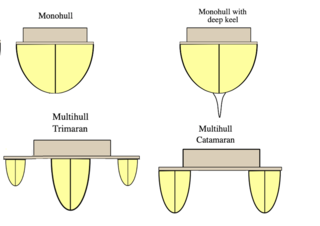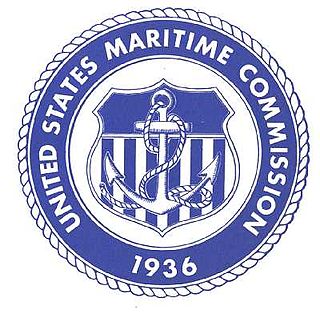Related Research Articles

A multihull is a boat or ship with more than one hull, whereas a vessel with a single hull is a monohull. The most common multihulls are catamarans, and trimarans. There are other types, with four or more hulls, but such examples are very rare and tend to be specialised for particular functions.

The Ferengi are a fictional extraterrestrial species in the American science fiction franchise Star Trek. They were devised in 1987 for the series Star Trek: The Next Generation, played a prominent role in the following series Star Trek: Deep Space Nine, and have made brief appearances in subsequent series such as Star Trek: Voyager, Star Trek: Enterprise, Star Trek: Discovery, Star Trek: Lower Decks and Star Trek: Picard.

The Royal Netherlands Navy is the naval force of the Kingdom of the Netherlands.

A trimaran is a multihull boat that comprises a main hull and two smaller outrigger hulls which are attached to the main hull with lateral beams. Most modern trimarans are sailing yachts designed for recreation or racing; others are ferries or warships. They originated from the traditional double-outrigger hulls of the Austronesian cultures of Maritime Southeast Asia; particularly in the Philippines and Eastern Indonesia, where it remains the dominant hull design of traditional fishing boats. Double-outriggers are derived from the older catamaran and single-outrigger boat designs.

Landing craft are small and medium seagoing watercraft, such as boats and barges, used to convey a landing force from the sea to the shore during an amphibious assault. The term excludes landing ships, which are larger. Production of landing craft peaked during World War II, with a significant number of different designs produced in large quantities by the United Kingdom and United States.

A nuclear submarine is a submarine powered by a nuclear reactor, but not necessarily nuclear-armed. Nuclear submarines have considerable performance advantages over "conventional" submarines. Nuclear propulsion, being completely independent of air, frees the submarine from the need to surface frequently, as is necessary for conventional submarines. The large amount of power generated by a nuclear reactor allows nuclear submarines to operate at high speed for long periods, and the long interval between refuelings grants a range virtually unlimited, making the only limits on voyage times being imposed by such factors as the need to restock food or other consumables.

Eggnog, historically also known as a milk punch or an egg milk punch when alcoholic beverages are added, is a rich, chilled, sweetened, dairy-based beverage. It is traditionally made with milk, cream, sugar, egg yolks, and whipped egg whites. Distilled spirits such as brandy, rum, whisky or bourbon are often a key ingredient.

The United States Maritime Commission (MARCOM) was an independent executive agency of the U.S. federal government that was created by the Merchant Marine Act of 1936, which was passed by Congress on June 29, 1936, and was abolished on May 24, 1950. The commission replaced the United States Shipping Board which had existed since World War I. It was intended to formulate a merchant shipbuilding program to design and build five hundred modern merchant cargo ships to replace the World War I vintage vessels that comprised the bulk of the United States Merchant Marine, and to administer a subsidy system authorized by the Act to offset the cost differential between building in the U.S. and operating ships under the American flag. It also formed the United States Maritime Service for the training of seagoing ship's officers to man the new fleet.

BWX Technologies, Inc., headquartered in Lynchburg, Virginia is a supplier of nuclear components and fuel to the U.S. On July 1, 2015, BWX Technologies Inc. began trading separately from its former subsidiary Babcock & Wilcox Enterprises Inc. after a spinoff. Sandy Baker became CEO and Fees became chairman. The company had 2,500 employees in Lynchburg and 4,500 in total.

Topsail Island is a 26-mile (41.8 km) long barrier island off the coast of North Carolina, roughly equidistant between the barrier islands of the Crystal Coast and the beaches of the Cape Fear region, lying south of Jacksonville, North Carolina and Camp Lejeune. The northeastern edge of the island is the New River Inlet, and the southwestern edge is New Topsail Inlet. It is separated from the mainland by a series of small sounds and channels that make up a portion of the Atlantic Intracoastal Waterway.

Egg-and-dart, also known as egg-and-tongue, egg-and-anchor, or egg-and-star, is an ornamental device adorning the fundamental quarter-round, convex ovolo profile of moulding, consisting of alternating details on the face of the ovolo—typically an egg-shaped object alternating with a V-shaped element. The device is carved or otherwise fashioned into ovolos composed of wood, stone, plaster, or other materials.

Victor Mayer founded the jewellery manufacture Victor Mayer in Pforzheim in 1890. In the time of Jugendstil / Art Nouveau, the company created pieces based on the designs of well-known artists such as the jewellery designer Professor Georg Kleemann or Anton Krautheimer of the Munich Secession. In the art deco period and in the 1950s the manufacture focused mainly on fine gold and silver ware. From the 1970s onwards again more jewellery was manufactured. Until 1988 the company produced Fabergé jewelry for Fabergé & Cie in Paris with the label 'Fabergé Paris'. From 1925 until 2009, the company continued to produce Fabergé jewelry under license from Unilever New York until the brand license was sold. The manufacture Victor Mayer is well known for its high-end jewellery and the preservation of historical artisan techniques such as authentic fire enamel or guilloché.
"Heart of Stone" is the fourteenth episode of the third season of the American science fiction television series Star Trek: Deep Space Nine, and originally aired on February 6, 1995 in broadcast syndication. The story was written by Ira Steven Behr and Robert Hewitt Wolfe, while the episode was directed by Alexander Singer and the score was created by David Bell.
"Valiant" is the 146th episode of the television series Star Trek: Deep Space Nine, the 22nd episode of the sixth season. It was first broadcast on television on May 4, 1998.
Arthur Piver was a World War II pilot, an amateur sailor, author, printshop owner and legendary boatbuilder who lived in Mill Valley on San Francisco Bay and became "the father of the modern multihull."

Chicken Switch is a Melvins remix album by various noise and experimental artists, released on September 29, 2009. Unlike usual remix albums where the remixer is given a single track to work with, for Chicken Switch each remixer was given a full album to work with and pull from to create their track. The song names were also newly selected by their remixer.

Ichthyoplankton are the eggs and larvae of fish. They are mostly found in the sunlit zone of the water column, less than 200 metres deep, which is sometimes called the epipelagic or photic zone. Ichthyoplankton are planktonic, meaning they cannot swim effectively under their own power, but must drift with the ocean currents. Fish eggs cannot swim at all, and are unambiguously planktonic. Early stage larvae swim poorly, but later stage larvae swim better and cease to be planktonic as they grow into juveniles. Fish larvae are part of the zooplankton that eat smaller plankton, while fish eggs carry their own food supply. Both eggs and larvae are themselves eaten by larger animals.
Eggnog or egg nog is a beverage traditionally made with milk and/or cream, sugar, whipped eggs and sometimes distilled spirits.

Victor Tchetchet was a pioneering early modern multihull sailboat designer from Ukraine who is thought to have coined the term 'trimaran', though Éric de Bisschop built a trimaran in France earlier. He was also a landscape and portrait painter.
Egg Nog was a trimaran sailboat designed and built by Victor Tchetchet in New York City in the early 1950s, after his late 1940s vessel T26 and before Egg Nog II.